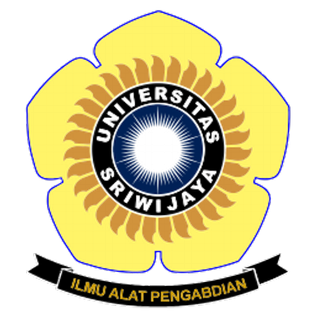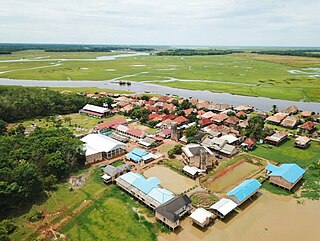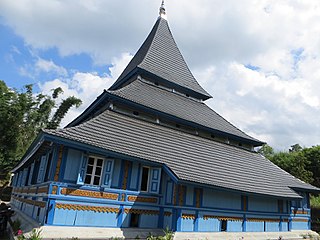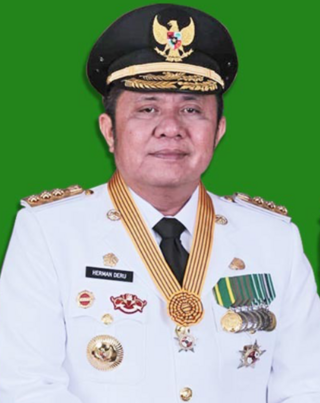
Rumah ulu is a vernacular house found in the highlands of South Sumatra, Indonesia. The house is associated with the Uluan people, who reside in the region upstream of the Ogan and Musi rivers.

Rumah ulu is a vernacular house found in the highlands of South Sumatra, Indonesia. The house is associated with the Uluan people, who reside in the region upstream of the Ogan and Musi rivers.
Rumah ulu is a traditional house of people living upstream of Musi River, South Sumatra. The name ulu is derived from the word uluan, which means "upstream". The term is also used as a generalization for rural inhabitants of the mountain range of Central Bukit Barisan upstream of the River. The current province of South Sumatra encompasses only a small part of the former administrative region of South Sumatra (the present Sumbagsel or Southern Region of Sumatra), consisting of the provinces of Bengkulu, Jambi, Lampung, and South Sumatra proper (the former Palembang Sultanate). [1]
With modernity, less and less rumah ulu can be found in the hinterland. No new ulu house have been constructed since the 1920s. [2] A 200 years old ulu house is kept in the Balaputradeva Museum. The rumah ulu in the museum was taken from Asamkelat Village in Pengandonan Subdistrict of Ogan Komering Ulu Regency. [3] A couple of old and large rumah ulu can still be found near Baturaja, although without conservation status, these too may be destroyed.
Rumah ulu evolved from an older type of houses known as the rumah uluan, the most basic form of rumah ulu. Rumah uluan is basically a type of wooden stage house, typical vernacular architecture in the Nusantara archipelago. [2]
Rumah uluan was built over very thick wooden posts (tiang duduk/kong), usually numbered six to nine. The posts are about 1.5 metres (4.9 ft) high. A strong hardwood e.g. ulin is used for the posts. [3] The posts are not sunk into the ground, but stand over a flat river stone. [2]
The proper house (dalam) has a square layout. [3] Construction method for the house involves placing a complete frame of the house on top of the posts. The layout is simple, with space divided into two different levels by a 15 centimetres (5.9 in)-high dividing beam (sengkar). The lower area (tempuan), about two-thirds of the total floor area, is where the entrance is located. The lower space is used to prepare and to consume food, with the hearth placed in one corner. In a larger house, the kitchen is located in an additional building known as the beruge. The higher one-third floor area (luan) marks the more private sleeping area. This higher area is also used as the place where elders, or members of the bridge-giving lineage, were seated. The word luan means "stern" of a boat. [2]
Rumah uluan's roof is characterized with projecting gables and rafters which rest on flying roof plates. The construction technique is similar with the Toba Batak houses. [2]
The degree of decorations indicates the wealth of the house owners. Relief carvings (tatahan) are found in places e.g. on the studs and beams of the frame. Frequent motifs are floral e.g., bunge bulan (moonflower) or kembang matahari (sunflower), usually carved on door and the outside of the luan wall. [2]
The interior of rumah ulu is divided into three parts namely the front room, the middle room, and the back room. These three spaces are further divided into rooms e.g. the living room (garang or lintut); the resting room (haluan/luan and kakudan); the elder room (ruang gedongan or ambin), and ruangan dapur (kitchen). [4] [3]
The living room (garang or lintut) is the place where the homeowner can have a chat in the afternoon after doing a work routine. The resting room is divided into a male resting space (haluan) and a female resting space (kakudan). The elder room (ruang gedongan or ambin) is the most central part of the rumah ulu and is located on the highest platform in the house. This room is used for the eldest of the family to give counsel or share wisdom in the form of stories to the children and the grandchildren. [4] [3]
The hierarchy of space of the uluan is defined by a rule known as the ulu-ulak (ilir) system. In village organization, if a new younger member of the family is planning to build a new house, the house must always be situated on the downstream side of the older house. This results in a clear village organization where the oldest house in the village is always located on the upstream side. [4]

Palembang is the capital city of the Indonesian province of South Sumatra. The city proper covers 352.51 square kilometres on both banks of the Musi River in the eastern lowlands of southern Sumatra. It had a population of 1,668,848 at the 2020 Census; the official estimate as at mid 2023 was 1,772,492. Palembang is the second most populous city in Sumatra, after Medan, and the twelfth most populous city in Indonesia.

South Sumatra is a province of Indonesia, located in the southeast of the island of Sumatra. The capital and largest city of the province is the city of Palembang. The province borders the provinces of Jambi to the north, Bengkulu to the west and Lampung to the south, as well a maritime border with the Bangka Belitung Islands to the east. It is the largest province in the island of Sumatra, and it is slightly smaller than Portugal, the department of Boquerón in Paraguay or the U.S. state of Maine. The Bangka Strait in the east separates South Sumatra and the island of Bangka, which is part of the Bangka Belitung Islands province. The province has an area of 91,592.43 km2 (35,364 sq mi) and had a population of 8,467,432 at the 2020 census; the official estimate as at mid-2023 was 8,743,522. The province is rich in natural resources, such as petroleum, natural gas and coal. The province is inhabited by many different Malay sub ethnic groups, with Palembangese being largest ethnic group. Most speak the Palembang language, which is mutually intelligible to both Indonesian and local Palembang Malay. Other ethnic groups include the Javanese, Sundanese, Minangkabau and Chinese. Most are concentrated in urban areas and are largely immigrants from other parts of Indonesia.

Rumah Gadang or Rumah Bagonjong "house for the Minangkabau people" are the traditional homes of the Minangkabau in West Sumatra, Indonesia. The architecture, construction, internal and external decoration, and the functions of the house reflect the culture and values of the Minangkabau. A Rumah Gadang serves as a residence, a hall for family meetings, and for ceremonial activities. In the matrilineal Minangkabau society, the Rumah Gadang is owned by the women of the family who live there; ownership is passed from mother to daughter.

Sriwijaya University is a research, teaching and learning center which has contributed significantly in the development and advancement of sciences, technologies, arts and cultures. Being one of the major state universities in Indonesia, Sriwijaya University's initial campus is located in Palembang, the capital of South Sumatera Province, and the second campus is located in Indralaya, Ogan Ilir Regency approximately 32 km away from Palembang.

Ogan Komering Ilir Regency is a regency of South Sumatra Province, Indonesia. It takes its name from the Ogan River and the Komering River, which are the two main rivers that drain the area. The name Ilir means downstream. The administrative centre is the town of Kayu Agung. The regency borders Banyuasin Regency to the northwest, Bangka Strait, and the Java Sea to the east, Lampung Province to the south, and Palembang city, Ogan Ilir Regency, and East Ogan Komering Ulu Regency to the west.

Ogan Ilir Regency is a regency of South Sumatra Province, Indonesia. It takes its name from the main river which stream that area, Ogan River. And the name Ilir means downstream. Indralaya is the regency seat. The regency borders Palembang City and Muara Enim Regency to the north, Ogan Komering Ilir Regency to the east, Ogan Komering Ilir Regency, and East Ogan Komering Ulu Regency to the south, and Muara Enim Regency to the west.

Baturaja is a town and the administrative capital of Ogan Komering Ulu Regency in South Sumatra, Indonesia. It has an area of 235.27 square kilometres and had a population of 142,099 people at the 2020 Census; the official estimate as at mid 2023 was 149,116.

Rangkiang is a granary or rice barn that the Minangkabau people used to keep rice in. The rangkiang is a distinctive feature of Minangkabau architecture. The structure is traditionally found in the courtyard of a rumah gadang, the traditional house of Minangkabau people.
Palembang is the capital city of South Sumatra province of Indonesia. Currently, this city is the oldest existing city in Indonesia, dates back to 7th century. Palembang was once the capital city of Srivijaya, a Palembang empire which ruled parts of the western archipelago and controlled maritime trade routes especially in the Strait of Malacca. Palembang incorporated into Dutch East Indies in 1825 after the abolishment of Palembang Sultanate. Palembang is chartered as a city on 1 April 1906. Palembang today is the second largest city in Sumatra and the ninth largest city in Indonesia. The city has become host of several international events, including 2011 Southeast Asian Games and 2018 Asian Games.

The Bingkudu Mosque is one of the oldest mosques in Indonesia. It was founded by the Padri in the wake of the Padri War in West Sumatra in 1823. This mosque with typical Minangkabau style architecture is located in Jorong Bingkudu, Nagari Canduang Koto Laweh, Canduang District, Agam Regency, West Sumatra. When it was first built, the building of the mosque was made of wood on its floor, pole, and wall.

Koto Baru Grand Mosque is one of the oldest mosques in Indonesia located in Koto Baru Nagari, Sungai Pagu District, South Solok Regency, West Sumatra.

A balairung is a village hall of the Minangkabau people of West Sumatra, Indonesia. It has a similar architectural form to the rumah gadang, the domestic architecture of the Minangkabau people. Whereas a rumah gadang is a proper building, the balairung is a pavilion-like structure used solely for holding a consensus decision-making process in the Minang society.

Herman Deru is an Indonesian politician who served as the governor of South Sumatra between 2018 and 2023, and was formerly Regent of East Ogan Komering Ulu between 2005 and 2015.
This is a list of emblems or coat of arms used in Indonesia. Indonesia is divided into 38 provinces, and each province is divided into regencies (kabupaten) and cities (kota). There are 416 regencies and 98 cities. Each province, regency, and city has its own emblem.
Chalik Effendi was an Indonesian politician who was mayor of Bengkulu between 2002 and 2007.

The Komering are an ethnic group that inhabits along the Komering River in South Sumatra province.